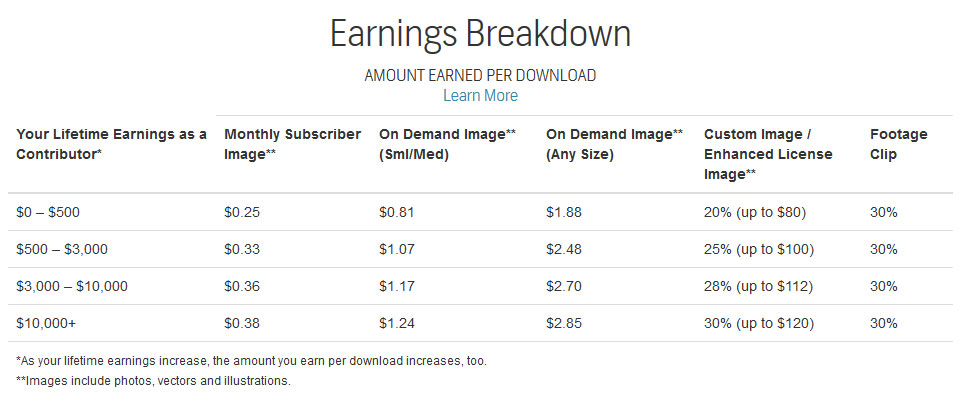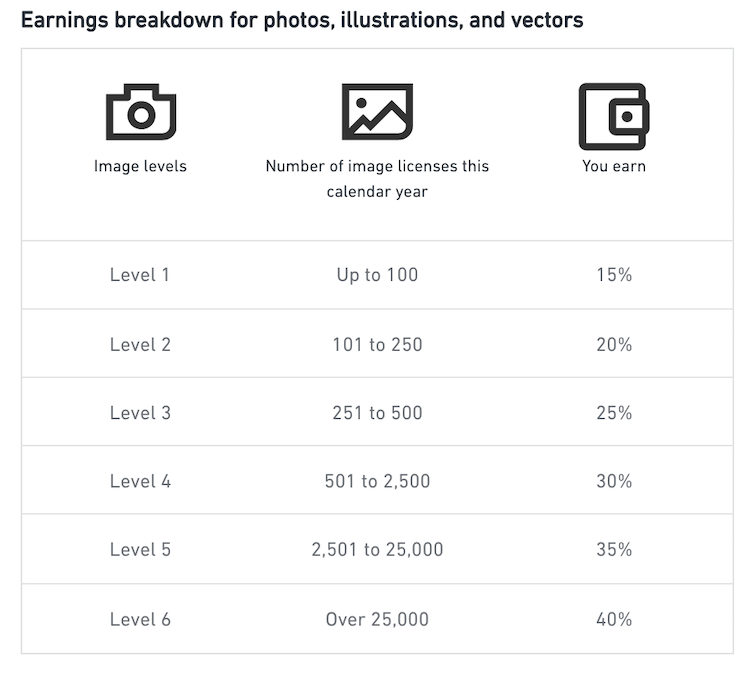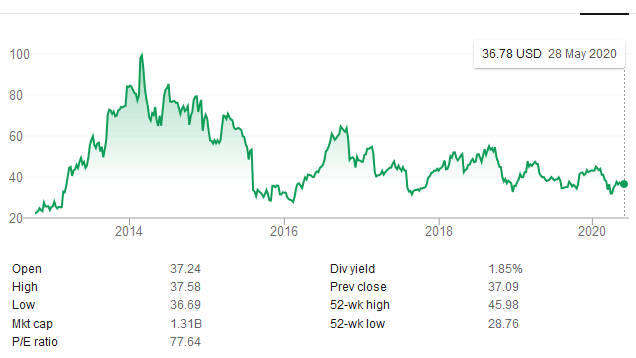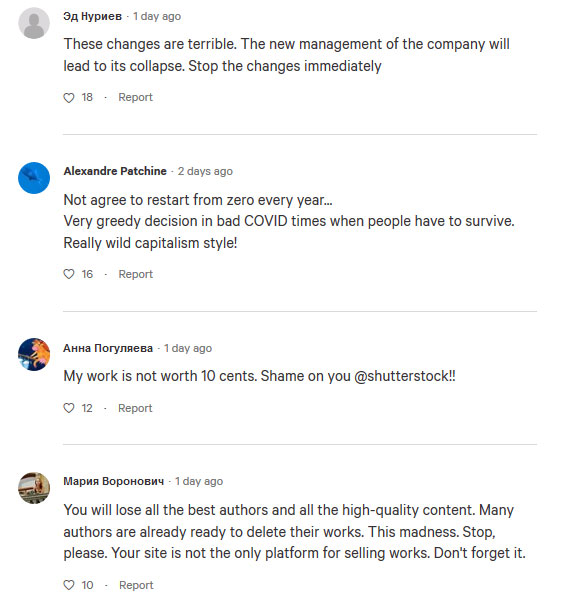Microstock photo agency, ShutterStock, has infuriated contributors by announcing an overhaul of its royalty earnings structure, resulting in a major pay cut for its top photographers.
 Shutterstock is a major player in the microstock race-to-the-bottom business model. The once-lucrative stock photography market, a sole income source for many photographers, has been reduced to a supplementary income avenue only worth a few extra dollars. Over time agencies like Shutterstock and Getty Images have driven down the price of stock photography, while simultaneously lowering contributor commission fees.
Shutterstock is a major player in the microstock race-to-the-bottom business model. The once-lucrative stock photography market, a sole income source for many photographers, has been reduced to a supplementary income avenue only worth a few extra dollars. Over time agencies like Shutterstock and Getty Images have driven down the price of stock photography, while simultaneously lowering contributor commission fees.
Despite its role in eroding the market, Shutterstock maintained loyal contributors partly due to its ‘Lifetime Earnings’ payment structure – four tiers rewarding photographers based on their sales generated over a lifetime.
New contributors start out at the lowest tier, US$0 – $500, and earn $0.25 per subscription image purchase or $0.81 per on-demand image (small-medium). Long-time contributors, who have generated over US$10,000+, earn $0.38 per subscription image or $1.24 per on-demand image.

It’s a significant difference, especially if a contributor generates hundreds of sales off an existing library. They sit back and allow the Shutterstock sales build, and enjoy the long-term benefits of sticking with them. Well, not anymore!
Shutterstock’s new royalty structure resets every year, and the photographer’s fee percentage rate is determined by six tiers that’s based on how many images are licensed each year.

Photographers at the First Tier will earn a 15 percent cut until they license 100 images, Second Tier photographers earn earn 20 percent until they move 250 images, and the top Sixth Tier earns a photographer 40 percent after licensing over 25,000 images. When January 1 rolls around, all contributors move back to the First Tier and climb back up the ladder.
The new structure will kick into effect from June 1 – Shutterstock provided just five days notice – and contributors will start at the tier based on their download count for 2020.
Naturally, Shutterstock attempted to frame this as some kind of virtue to contributors. ‘We are making this adjustment in order to reflect changes in the market for creative content, help to create fair opportunities for all our contributors, and reward performance with greater earnings potential,’ Shutterstock told contributors in an e-mail.
Back in February Shutterstock founder and CEO, Jon Oringer, stood down and was replaced by Shutterstock president, Stan Pavlovsky. Shutterstock went public in 2012 and in two years the share price surged over 600 percent, making Oringer New York’s first tech billionare with a 50 percent ownership of the company. But, in recent years, Shutterstock has underperformed the market and Pavlovsky was brought in with, in classic corporatese, a ‘three-legged strategy’, which involves ‘expanding the marketplace’s margins’.

This blatant pay cut to long-time photographers is clearly designed to benefit Shutterstock and its shareholders, who probably need a reason to hang on as the corporation attempts to bounce back on the New York Stock Exchange. Contributors on the Shutterstock forums have naturally responded accordingly.
Richard Whitcombe, an underwater photographer with over 14,000 images on Shutterstock: ‘Just when you think Shutterstock couldn’t completely and utterly screw the contributors and more you’ve gone and done it,’ wrote Richard Whitcombe, an underwater photographer with over 14,000 images on Shutterstock. ‘Effectively with a January reset, everybody gets a cut of 20 percent or more of earnings to a new laughably tiny amount and it’ll take months to claw back the level they’ve been earning previously. So most people are going to go most of the year for half or less than they currently get. It’s a plus 50 percent pay cut for most users. You’ve descended to iStock level of contempt for contributors.’
THPStock, an Australian contributor with 6480 images in Shutterstock: ‘I almost never come to the forums despite being with Shutterstock for a decade and referring thousands of customers and buyers. But this announcement is so bad that I just had to say something. Why would you follow the same path that you have seen other agencies take, that every single contributor has hated and been angered by?
As if the overall strategy of this isn’t bad enough, this line is the real kicker: “All contributors reset to level 1 for both images and videos every year on January 1st.”
So for the first few months of the year, many contributors will be earning 15-25 percent only! Even big contributors have to take a hit on their first few sales every year?! Why?! I know it’s too late, but this whole approach should be reversed.’
Martin Christopher Parker, with 3289 images on Shutterstock: ‘Wow your greed knows no bounds. That’s the end of my account with you. I suspect I won’t be the only one.’
Todd Taulman, a US photographer with 1643 images on Shutterstock: Just the next way the corporation screws the creatives. With over 40,000 lifetime downloads for this company, I find this reprehensible, but not unexpected. Death of stock imagery is coming. Better for my studio, creating more custom content for clients.
But you know all of us could screw the corporation by not uploading any content. Organise into a union and demand better.
And on it goes, for 75 pages on the Shutterstock forums, with the vast majority of users extremely unhappy. A Change.org petition calling for Shutterstock to remove this ‘injustice to its contributors’ has garnered over 3400 signatures in two days.

So, will Shutterstock listen to the pleads from its contributors? Or will the tasty financial benefits from this pay cut drown out all background noise?





As a long time purchaser of shutterstock photos, can somebody recommend a provider that pays their contributors fairly?
Adobe and Dreamstime also Picfair
Perhaps you can consider Dreamstime or AdobeStock. The best way would be to purchase from contributors directly, but in many cases that would be impractical 🙁
I am not sure it can be called fairly, because it’s still rather low for the work some photographers put into their work, but Adobe Stock pays considerably better than Shutterstock.
There would also be Alamy, they pay really high, but I would not call them contributor-friendly, as they don’t pay properly (you have to sometimes run behind them for months (!) to get your money, sometimes simply don’t register sales at all (you will find an image of yours used on a website with credits back to Alamy, but the sale is not listed anyhwhere on your Alamy dashboard for you and then you have to run after them to get that sale even registered again and if you had not found that image by sheer luck, you would never have found out. Don’t even want to know how often this happens without contributors ever knowing and ever seeing any money for their images, as, of course, I only know of the cases where contributors found out and told me about it) and they give customers easy means to scam contributors by offering a very chap “private use licence” (which often is bought for images that have absolutely no personal use value, like a shot of an airport. Who is printing that on personal Christmas gift cards for their family?) as well as allowing customers to claim a refund for their money months after the purchase (while you can find your image being used by that company and you get no explanation why the money was refunded). So, while their royalities are in principle high, they really open up a whole new can of worms of possible contributer exploitation.
Also, Alamy has no real quality control for images, they just do sample control and don’t check for property or model releases, so there is always a high risk for customers that they might purchase an image, they are actually nota llowed to use in the way they thought they could.
Thanks for the support Mary. At the moment Adobe stock offers a better deal for photographers, and you will get the same images at equally good prices.
Therefore, we say #boycottshutterstock
Getty and Shutterstock did not drive down the price of stock photography, the market did that. Photographers who are complaining should focus their ire on their fellow photographers who give away their work for free on all the free stock photo sites.
Really? It’s the fault of fellow photographers that Shutterstock thinks keeping up to 85% of royalties for themselves is ok? That download plans will seldom be completely used and thus the remaining money stays with Shutterstock to 100%?
Let’s please assign the blame where truly due in this case
I really recommend Adobe Stock and Pond5 which are treating its contributors fairly and with respect. Not like this ShutterCrap!
You mean, Shitterstock.
Interesting comment Tim Collins…I do agree that for many years now the image market place has changed to almost a ‘free for all’ mindset. For those like Richard Whitcombe who have invested heavily on top range equipment and their time in providing high-end media the blow is the greatest to bear. Myself, with just over 1260 images on Shutterstock these past two years my sales are still on Level 1 but for many like me the urge to supply what the market wants has diminished to a trickle especially when the review process is virtually broken. With no real communication between the contributor and the image maker the frustration level is dire as my professional mindset is that customer is king and working as a strong team breeds success. There will always be those who want everything for free and 15 minutes of fame attitude but to underpin any commercial enterprise there has to be a strong cohesive foundation…
Mary—Dreamstime just announced a 10% increase in rates to contributors starting June 1st, (and they already paid better than most places). Alamy pays well too. Sales are pretty infrequent at both, though, which is why many contributors already put up Shutterstock and iStock (where I just sold a photo for 0.4 cents!). Adobe is decent.
On June 1st, we contributors are disabling our portfolios for as long it takes for SS to revert these changes. #BoycottShutterstock
I am currently in Level 4 with my Shutterstock illustration portfolio, but there’s no way I will be selling my images for ten cents per download! I already started to remove some of my best imagery. I will move all of it to Adobe. I also sell on Creative Market and will recommend that site, too. They pay 40% from each license, and since you can set your own prices, this works fine.
Regarding the direct sale of images to users. I think to try Openbazaar, and see the result
Alamy is also recommended. Aside Pond 5.
Interesting this Shutterstock do. So if I going to Africa and do a lot off movie and photo they think I will put it in Shutterstock for 10 cent ?. Is even low with 0.25 . Naa is will never happen. Believe is time to made a homesites selling self . Time to take away africa photo from this site. Adobe works. Am not for free
Shutterstock management don’t care about collapse and resetting royalty levels. They will sell the shares, rip off investors and run away. By the time we are resetting they are long gone. It’s investors that are stupid, and their stupidity affects all of us.
I’m a small contributor on shutterstock with 400+ images and 70-80 odd sales in a month when going good. And I’ve paused the sales. Like Gerhard Pettersson said even 0.25 is too low and by reducing it further shutterstock has certainly stooped too low. For a contributor, it’s like giving away the pictures/art/illustrations for free. I think if I push it on my blog for download for free I might earn better through ADs than selling on Shutterstock. Bye Bye Shutterstock.
Time for the contributors to unite and pause sales.
Lol, i was planning to put a few images on Shutterstock and searched for their payment plan. Found it and immediately went searching for better alternatives and ended up here. I’m sorry for Shutterstock, but charging me 85 percent of the earnings for putting images on your site just isn’t worth it.
And then there is the generous remuneration for the fat cats of Shutterstock.
https://www.comparably.com/companies/shutterstock/executive-salaries
https://www1.salary.com/SHUTTERSTOCK-INC-Executive-Salaries.html
And these do not reflect the multi-tens-of-millions paid as bonuses to the CEO and other fat cats. Search for yourself.
They rob from those who put food on their table. Disgusting. Do not support these thieves.
The Shareholders are sitting on their hands, allowing this to happen.
Because everyone has a camera, they can now be a professional photographer if they sell any image regardless of what they sell for. Even photos taken with a cell phone sell. I was a successful commercial photographer for 40 years and fortunately didn’t fall into the ripoff of the stock photo industry. Because of the ease of taking a picture now and editing them digitally it’s an open field for “wantabe” photographers driving prices down as many buyers feel they can do it themselves or simply don’t recognize true photo quality from someone who is truly talented. The digital industry has made it so much easier for stock photo companies to file and keep track of all the image types and qualities. Thus the sheer volume is incredible with similar images, some good and some bad to horrible. Those that make a living from stock are truly good photographers where most of the others are amateurs and some are advanced amateurs. Agencies will put up the images taken by these so called photographers only because the want volume over quality which reflects in the price. But the amateurs are the people that take the value down for images taken by the truly professional photographers. The good enough images as I call them. I’m just happy I don’t have to compete in this market and getting myself ripped off by these stock agencies.